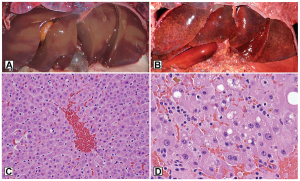 Sea Otters are turning up dead in central California. In 2007, 11 sea otters were recovered from Monterrey Bay. Over the last three years, dead otters washing up on beaches has reached a record high?
Sea Otters are turning up dead in central California. In 2007, 11 sea otters were recovered from Monterrey Bay. Over the last three years, dead otters washing up on beaches has reached a record high?
What could be causing all these otter deaths? Are there new predators in the area? Is there some kind of disease? Could increased otter deaths reflect an increase in otter populations, indicating not otter population decline, but otter population growth? The answer turns out to be even more surprising – freshwater algae.

Blue-green algae (technically a cyanobacteria) is found throughout the world in freshwater and estuary ecosystems. Although generally harmless, several strains have been identified that produce the toxin microcystin. Microcystin causes liver damage and may induce tumor development. Like mercury and other environmental toxins, microcystin undergoes trophic amplification – the higher up in the food chain you are, the bigger the dose you have. Until now, microcystin was considered a freshwater, not marine, problem.

In a recent paper from PLoS ONE, Miller et at. detected high concentrations of microcystin in dead sea otters, as well as liver damage from the contamination. They approach this study in a three-pronged attack.
1. Microcystin-producing harmful-algal blooms were confirmed in freshwater bodies in the same region as the dead otters, and microcystin was detecting in nearby estuary and marine systems.
2. Physical and chemical analysis of dead otter tissue confirmed damage caused by microcystin ingestion.
3. The mechanism for microcystin uptake through invertebrate food sources was established in laboratory experiments.
The third point forms the keystone of this study. Not only did they confirm that microcystin was present in the environment and present in the otters, but they provide a mechanism for the toxin to reach the sea otters through their food source. Otters with a major marine bivalve component in their diets that fed in areas near microcystin-producing algal blooms, are more susceptible to microcystin poisoning.
Several factors are in play here. The first and most obvious is that biological systems are connected. Problems with freshwater systems don’t just affect freshwater systems, marine ecosystems are not separate from freshwater ecosystems. Second, the cause of disease isn’t always obvious – before 1946 no one even knew that blue-green algae blooms were toxic, and even then no one though they were affecting marine ecosystems. This is, in fact, the first case of microcystin infecting a marine mammal. Finally, establishing a mechanism for uptake is essential for determining the underlying cause and designing a mitigation scheme. It’s not enough to know that microcystin exists and that sea otters have been contaminated with it, we also need to know how that contamination occurs, otherwise there’s no way to manage it.
~Southern Fried Scientist
Miller, M., Kudela, R., Mekebri, A., Crane, D., Oates, S., Tinker, M., Staedler, M., Miller, W., Toy-Choutka, S., Dominik, C., Hardin, D., Langlois, G., Murray, M., Ward, K., & Jessup, D. (2010). Evidence for a Novel Marine Harmful Algal Bloom: Cyanotoxin (Microcystin) Transfer from Land to Sea Otters PLoS ONE, 5 (9) DOI: 10.1371/journal.pone.0012576
This is really interesting. The biggest theory I’ve heard about this is that killer whales in the area are increasingly turning to sea otters as a source of food (and it takes a lot of sea otters to run a killer whale). It sucks for the otters that the seem to be getting hit from both the top-down and bottom-up.
I enjoyed this article too. I didn’t know the otters were having difficulties at all. As to the first comment: Is this true? Are otters also dealing with greater predation by killer whales?
Interesting.
I’m going to take a short moment to be a microbiologist: they aren’t algae, they are cyanobacteria. HUGE physiological difference. It’s mostly PLoSone’s fault for allowing that article title. Where’d the peer review go? My last paper changed it’s title three times! Anyway, the harmful creatures are cyanobacteria.
Okay, back down from soapbox. Typically, cyanobacteria bloom in places with lots of phosphorus contamination because they are nitrogen fixers. If we can convince people that dishwasher detergent kills Sea Otters maybe that’s a good environmental campaign! Cute creatures tend to help the cause.
Rosalind
Girls Are Geeks
You’re technically correct, but since cyanobacteria are colloquially referred to as “blue-green algae”, and Harmful Algal Bloom is an overarching description of the phenomenon, I see this as more along the lines of casually calling critters jellyfish or starfish than actually being a typo. This paper is clearly geared towards catching policymakers eyes.
But yeah, otters are way cuter than menhaden.
Menhaden are way tastier though.
The main citation for it is Estes et al. (1998) from Science. It was pretty controversial when it first came out. William Stolzenburg covers it really well in his book Where the Wild Things Were.